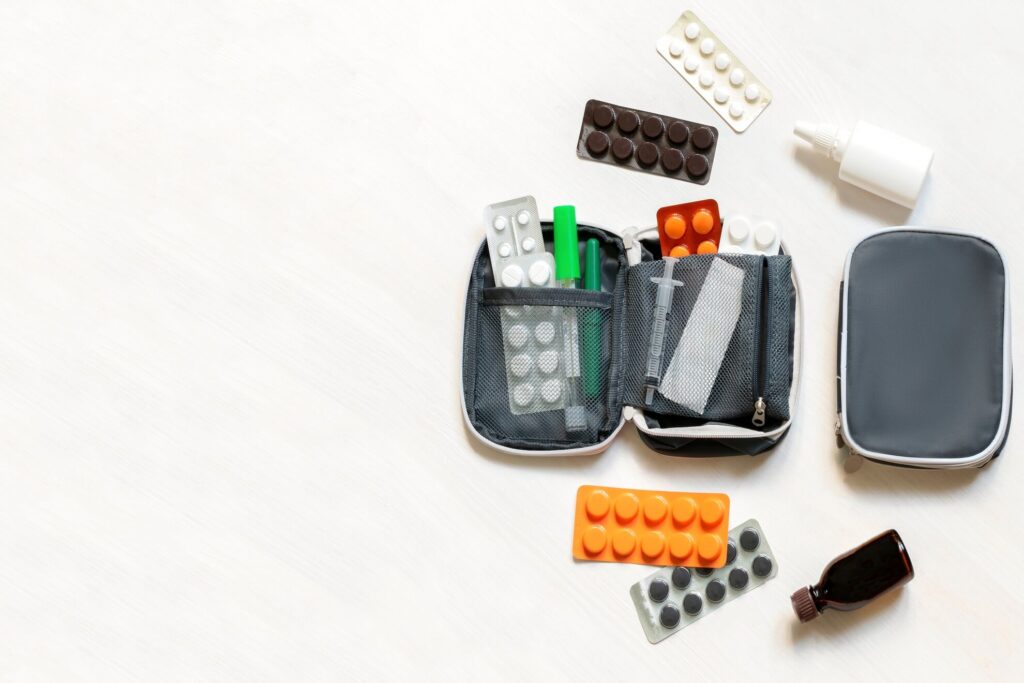Are you a frequent traveler who relies on prescribed medications to maintain your well-being? Or perhaps you’re a first-time flyer with concerns about how to navigate the skies with your essential drugs. Don’t panic – we’ve got you covered with our ultimate guide on how to pack prescription meds for air travel.
In this guide, we’ll explore the ins and outs of flying with prescribed drugs, from understanding airline regulations to organizing your medications and navigating security screenings.
Wondering, “How do I pack my prescriptions for air travel”?
We’ll equip you with the knowledge and confidence to embark on your travels with ease. So, let’s dive in and discover how to pack like a pro, ensuring your medications are as ready for takeoff as you are!

Prescription Medicine and Air Travel: Can You Fly with Medication?
The good news is that you can fly with your medication. Airlines and airport authorities understand the importance of carrying necessary medications during air travel. However, there are a few essential considerations to keep in mind to ensure a seamless journey.
We cover everything you need to know about international air travel with prescription medication below!
Understanding Airline & Airport Regulations for Flying with Prescribed Drugs
When you’re flying with prescribed drugs, it’s important to be familiar with the rules and regulations governing air travel so you can ensure everything is in order when packing prescription medication for air travel.
Also, keep in mind that different airlines and countries may have specific guidelines, so you should do your own research on each destination to avoid any unnecessary hassles or delays.
Here’s what you need to know about air travel with prescription drugs:
Carrying prescribed drugs on flights:
- Passengers are generally allowed to carry prescribed medications both in their carry-on luggage and checked bags. But when packing prescriptions for air travel, it’s strongly recommended to keep your essential medications in your carry-on to ensure immediate access during the flight.
- Avoid packing medications in unmarked containers or plastic bags. Instead, use their original pharmacy-labeled packaging whenever possible.
Proper documentation and identification:
- Carrying proper documentation is crucial when you’re planning air travel with prescriptions. Make sure to bring your original prescription labels with your name, medication details, and prescribing doctor’s information clearly printed.
- If you’re traveling with injectable medications or medical devices like syringes, carry a doctor’s note or medical certificate stating their necessity.
Specific restrictions and limitations:
- Liquids and gels: If you’re not sure how to pack prescription meds for travel, you should know, the TSA’s 3-1-1 rule applies to liquid medications as well. You can carry medications in liquid or gel form, but they must be in containers of 3.4 ounces (100 milliliters) or less and fit into a clear quart-sized bag. Medications are exempt from the 3-1-1 rule but be prepared for additional screening if needed.
- Controlled substances: When it comes to air travel and prescription drugs, you should do extra research if your prescribed drugs fall under controlled substances, such as certain pain medications or anxiety drugs. Check the specific regulations of the destination country and obtain any necessary permits or approvals in advance.
TSA regulations:
The Transportation Security Administration (TSA) is a federal agency that is responsible for security at airports and other transportation hubs in the United States. The TSA has regulations on flying with prescribed medicines in order to ensure the safety of passengers and crew members.
These regulations are important because they help to prevent the illegal transportation of controlled substances and other dangerous materials. They also help to ensure that passengers have access to their essential medications in case of an emergency and that they adhere to regulations on packing prescription drugs for air travel.
The full TSA regulations on flying with prescribed medicines can be found on the TSA website. However, here are some key points to keep in mind:
- You can bring your prescribed medications in your carry-on luggage or your checked luggage.
- Liquid medications must be in containers of 3.4 ounces (100 milliliters) or less and must fit in a clear quart-sized bag.
- You may need to declare controlled substances to the TSA.
- Be prepared to show documentation for your medication, such as your prescription or a doctor’s note.
If you are traveling with a large quantity of medication, you may need to declare it to the TSA. You can request a private screening if you prefer not to disclose personal medical information in public.
Always check the official websites of your airline, the TSA, and the destination country’s aviation or transportation authority for the most up-to-date information on air travel regulations prescription drugs and more information on how to pack prescription meds for air travel. Remember, it’s better to be over-prepared than to be caught unaware, so take the time to understand and follow these regulations to make your journey as smooth as possible.

Consult with Your Healthcare Provider
Before you travel (and learn how to pack prescription meds for air travel), it’s important to consult with your healthcare provider to discuss your medication needs. They can help you adjust your medication schedule, ensure you have an adequate supply, and advise you on how to store your medications safely.
Here are some things to discuss with your healthcare provider:
- Your travel plans, including the duration of your trip, the destinations you’ll be visiting, and any potential challenges or concerns you anticipate.
- Any changes in your medication schedule that may be necessary due to time zone changes or disruptions to your regular routine.
- The need for additional prescriptions to cover the entire period of travel.
- How to store your medications safely, especially if they have specific storage requirements or are sensitive to temperature changes.
- Emergency contact information, including the number of your healthcare provider and the nearest hospital or clinic at your destination.
By consulting with your healthcare provider, you can ensure that your medications are well-managed during your travels and get info on how to pack prescription meds for air travel. This will help you stay on top of your health and enjoy your trip with peace of mind.
Organizing Medications
It’s important to know how to pack prescription meds for airline travel with prescription drugs, since proper organization of your medications is essential for easy access, safety, and convenience while traveling. Here are some tips:
- Use pill organizers to keep your medications neatly sorted and easily accessible.
- Label your medication containers clearly with your name, the name of the medication, dosage instructions, and any other relevant information.
- Keep your medications in their original packaging, especially for prescription medications.
- Separate medications by type to avoid confusion.
- Carry extra medications in case of unexpected delays or changes to your itinerary.
- Place liquid medications in sealable, clear plastic bags to comply with TSA regulations and prevent leaks.
- Carry your medications in your carry-on luggage for easy access.
By following these tips, you can ensure that your medications are well-organized and easily accessible while traveling.
How to Pack Prescription Meds for Air Travel: Carry-On or Checked Luggage
When packing prescription medications for air travel, it is generally recommended to keep them in your carry-on luggage. This ensures that you have immediate access to them during your flight and reduces the risk of lost or delayed luggage.
If you do choose to pack your medications in your checked luggage, be sure to pack extra medication in case of unforeseen circumstances. It is also important to check the specific regulations and guidelines of your airline regarding carrying prescription medications to ensure compliance and a smooth travel experience.
Here are some of the pros and cons of each option:
Carry-On Luggage
Pros:
- Immediate access to medications
- Mitigates the risk of lost or delayed luggage
Cons:
- Liquid restrictions (3-1-1 rule)
Checked Luggage
Pros:
- Convenience
- Ease of travel
Cons:
- Risk of lost or delayed luggage
- Limited access to medications during security screenings
Following these tips helps ensure that your prescription medications are safe and accessible during your flight.
Documentation and Labeling
When it comes to international air travel with prescription drugs, it is important to carry proper documentation and ensure clear labeling. This will help you verify the legitimacy of your medications, expedite security clearance, and comply with international travel requirements.
For documentation, carry the original prescription labels or packaging provided by the pharmacy. These labels should include your name, the medication’s name, prescribing doctor’s information, and the dosage instructions. Additionally, consider obtaining a letter or note from your healthcare provider explaining the necessity of your prescribed medications, especially for controlled substances or injectable medications.
For labeling, you can use adhesive labels or waterproof markers to write your name, dosage, and any other relevant information directly on the medication packaging. Alternatively, you can attach removable labels or use medication-specific labeling systems designed for this purpose.
Clearly labeling your medications will help you identify them easily, stay organized, and maintain medication adherence. It will also help prevent mix-ups or accidental ingestion of the wrong medication.
By carrying proper documentation and labeling your medications clearly, you can enhance safety, facilitate security screenings, and demonstrate compliance with regulations. It will also help you manage your medications effectively while traveling, ensuring a worry-free and well-organized journey.

How to Pack Prescription Meds for Air Travel: Security Screening and Airport Procedures
When going through security at the airport, it’s important to be prepared and aware of how it may affect your prescribed medications. Here are some tips to help you navigate the process smoothly:
- Medication Screening: Prescription medications are allowed through security checkpoints, but they may be subject to additional screening procedures. Be ready to present your medications separately for inspection if requested.
- X-ray Scanning: Medications, including pills and inhalers, can typically go through X-ray scanners without any issues. However, you can request a manual inspection instead if you prefer that your medications are not X-rayed.
Communicating with Security Personnel:
- Inform Security Officers: Advise the security officers that you are carrying prescribed medications and have them readily accessible for inspection. Clear communication from the start helps prevent any misunderstandings and ensures a smoother process.
- Carry Documentation: Carry your prescriptions or doctor’s notes with you and present them if requested. Proper documentation strengthens the legitimacy of your medications and can expedite the screening process.
Private Screening Option:
- Request Privacy: If you feel uncomfortable or prefer additional privacy during the screening process, you have the right to request a private screening. This allows you to discuss your medications confidentially and address any concerns or questions you may have.
Remember, security personnel are trained to handle situations involving prescription medications and medical needs. By cooperating, communicating clearly, and being prepared, you can navigate the security screening process with ease and ensure the safety and accessibility of your prescribed drugs.
Other Tips for a Smooth Journey
In addition to the tips mentioned earlier, here are some additional things you can do to ensure your air travel with prescription meds goes smoothly:
- Carry extra medication. This is especially important if you are traveling internationally, as there is a higher risk of luggage delays or loss. You should also carry extra medication if you have a chronic condition that requires you to take medication on a regular basis.
- Adjust your medication schedule for time zone changes. This can be done by gradually moving your medication times forward or backward by a few hours each day. If you are traveling across multiple time zones, you may need to adjust your medication schedule multiple times.
- Research local regulations. This is an important step to take before traveling to any country, as the regulations regarding prescribed medications can vary from country to country. You can usually find this information on the website of the country’s embassy or consulate.

What To Do If You Lose Your Medications?
If you happen to lose your prescribed medications while traveling, take the following steps to address the situation:
Stay Calm:
Losing your medications can be distressing but try to remain calm and composed. Panicking will make it harder to think clearly and find a solution.
Contact Your Healthcare Provider:
Reach out to your healthcare provider as soon as possible. Explain the situation and ask for guidance on what to do next. They may be able to provide advice, suggest alternatives, or assist with obtaining replacement medications.
Seek Medical Assistance:
If you require immediate medical attention or your condition is critical, seek medical help at a local healthcare facility or contact emergency services. Explain the situation and provide any relevant medical history to ensure proper care.
Locate the Nearest Embassy or Consulate:
If you are in a foreign country and need assistance, contact the nearest embassy or consulate. They can provide guidance, help facilitate communication with local healthcare providers, and assist in obtaining replacement medications if necessary.
File a Report:
If your medications were lost or stolen in a public place, consider filing a report with local law enforcement. This documentation may be required for insurance purposes or to facilitate any necessary legal processes.
Explore Local Healthcare Options:
Depending on your destination, there may be local healthcare facilities or pharmacies where you can seek assistance. Contact them and explain your situation to see if they can help provide replacement medications or suggest alternatives.
Arrange for Prescription Refills:
If you have travel insurance, check if it covers the cost of prescription refills in case of loss or theft. Contact your insurance provider to understand the process for obtaining replacement medications.
Consider Prescription Transfer:
If it is feasible, inquire about the possibility of transferring your prescription from your home pharmacy to a local pharmacy. This may require coordination between your healthcare provider, home pharmacy, and the local pharmacy.
Take Preventive Measures:
To minimize the risk of future medication loss, consider keeping medications in your carry-on luggage, ensuring proper labeling and documentation, and utilizing pill organizers to stay organized.
Remember, it is essential to consult with healthcare professionals and follow their advice in situations involving lost medications. They can provide the most accurate and appropriate guidance based on your specific circumstances.
How Air Doctor Can Help You Fill Prescriptions Abroad
Traveling abroad can be an amazing experience, but it can also be stressful. One of the biggest stressors is figuring out how to fill prescriptions if you get sick. In many countries, there are different healthcare regulations and it can also be difficult to find a doctor who speaks your language. This is where Air Doctor can help.
Air Doctor is an app that connects travelers to trusted, local doctors abroad. With Air Doctor, you can find a doctor who speaks your language and who is familiar with the local healthcare system. You can also get local, valid prescriptions.
Here are some of the benefits of using Air Doctor to fill prescriptions abroad:
- You can find a doctor who speaks your language.
- You can filter doctors according to other preferences.
- You can book clinic, at-home (hotel), or video consultations.
- You can get 24/7 multi-lingual support from the Air Doctor team.
- No lengthy claims processes.
- We’re partnered with insurance providers worldwide.
- Find trusted medical care, anywhere, anytime.
If you’re planning on traveling abroad, be sure to download the Air Doctor app so you can have peace of mind knowing that you’ll be able to get the medical care you need if you get sick.













